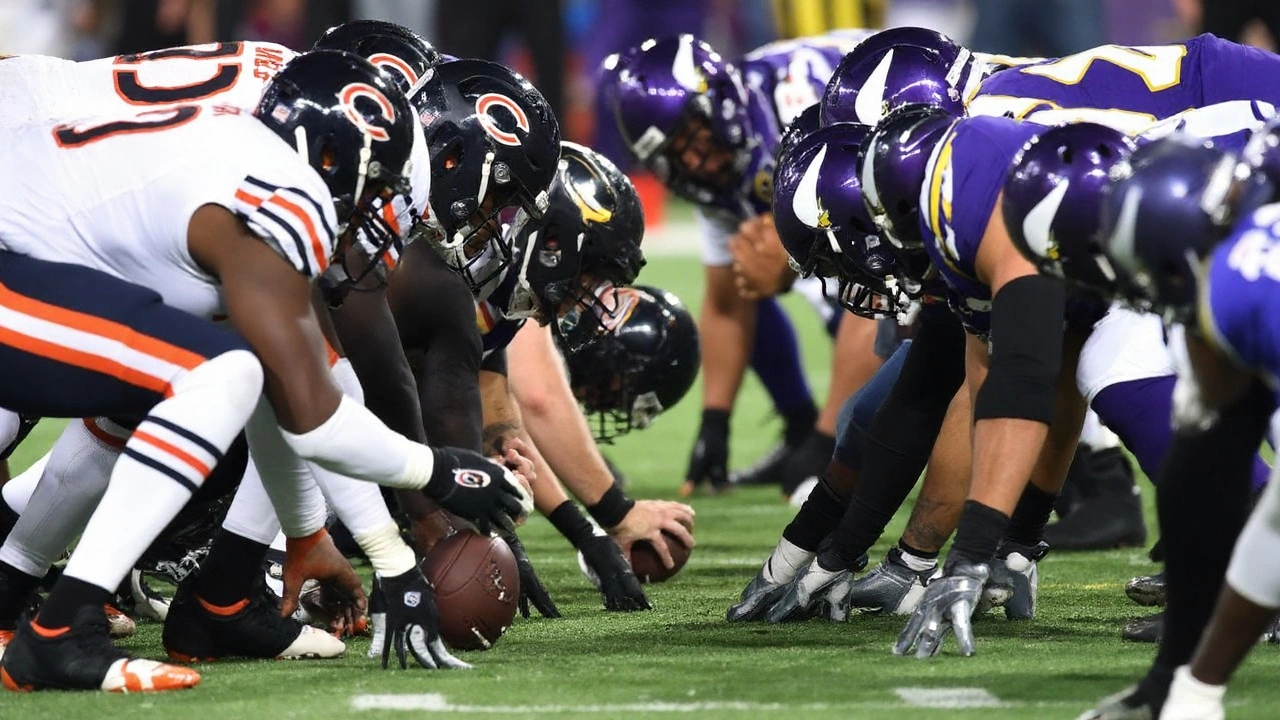J.J. McCarthy lifts Vikings to 21-point fourth-quarter comeback over Bears in MNF debut
 Sep, 9 2025
Sep, 9 2025
The rookie who wouldn’t blink: inside Minnesota’s fourth-quarter eruption
That roar you heard from the lakefront faded fast. The Minnesota Vikings trailed most of the night, their rookie quarterback looked rusty, and Soldier Field smelled blood. Then the fourth quarter happened. In the span of a few seismic minutes, J.J. McCarthy turned a choppy debut into the kind of Monday night plot twist that grabs a season by the collar.
Final score: Vikings 27, Bears 24. What sits underneath that number matters more. Minnesota scored 21 in the final quarter, with McCarthy tossing two touchdowns and punching in a rushing score to flip a game that had been slipping away. For a player who hadn’t taken a meaningful snap since leading Michigan to a national title at the end of the 2023 season, it was a nerve test and a reveal all at once.
This was McCarthy’s first real look at NFL speed after a lost 2024, when a knee injury wiped out his rookie season. The early series showed the rust: timing off, windows closing faster than expected, a Chicago front muddying reads with movement and disguised pressure. The Bears under new head coach Ben Johnson mixed coverages and kept everything in front, daring the kid to work underneath and earn every blade of grass.
Kevin O’Connell kept the faith. At halftime, the Vikings head coach pulled his quarterback aside and gave him a simple directive: “You are going to bring us back to win this game.” It wasn’t bluster. O’Connell clearly believed that once protection settled and the game plan leaned into rhythm throws, the rookie’s confidence would catch fire. He later described the look in McCarthy’s eye as steady, even in the messiest moments.
When the fourth quarter opened, Minnesota tilted the chessboard. The Vikings leaned into tempo, spread the field, and trusted their playmakers. The protection tightened just enough to let McCarthy set his feet and rip on time. The result was a cascade of drives that stressed Chicago horizontally first, then vertically. The throw that snapped the night into focus found Justin Jefferson, who notched his first touchdown of 2025 and ignited the sideline. You could feel the air shift in the stadium.
From there, McCarthy mixed quick-game decisiveness with just enough off-script play to keep the Bears from pinning their ears back. His rushing score — the kind of decisive, shoulder-down finish that sells a huddle on your resolve — underscored why Minnesota drafted him 10th overall in 2024. He is a timing passer by design, but the dual-threat element is a pressure valve. When he used it, the Bears had to play honest.
Chicago had chances. Rookie quarterback Caleb Williams flashed exactly what he showed on Saturdays: poise under duress, a live arm, and legs that change red-zone math. He scored his first NFL rushing touchdown and added a passing strike, giving Johnson a clear blueprint for a modern, flexible offense. For three quarters, the Bears stayed patient and looked in control. But when the game shrank to high-leverage snaps, the execution frayed.
The turning points stacked up fast, and painfully, for Chicago. A crucial Cairo Santos field goal try didn’t land, a late drive stalled, and the defense — tasked with too many fourth-quarter snaps — lost its edge in the final minutes. Those are the margins that separate a good debut from a memorable one. On Monday, the margins favored purple.
- Halftime hinge: O’Connell’s message to McCarthy set the tone for a calmer, cleaner second half.
- Jefferson’s jolt: His touchdown capped a drive built on rhythm throws and precise spacing, and it flipped the mood on both sidelines.
- The keeper: McCarthy’s rushing score signaled Minnesota would use his legs situationally, not just as a last resort.
- Special teams swing: Chicago’s missed field goal changed the math, forcing the Bears to chase downs instead of dictating pace.
- Rookie duel: Williams matched poise with playmaking, but Minnesota’s defense tightened when it had to, especially on third down late.
None of this works without the Vikings’ line adjusting. Early, interior pressure clogged Minnesota’s timing and funneled McCarthy into hurried throws. Late, protection calls and quicker concepts helped. You could see Minnesota go to bunch sets and motion to force softer leverage, buying clean sightlines and easier windows. That’s textbook O’Connell: treat the fourth quarter like a separate game, then call it accordingly.
For McCarthy, the intangible stuff mattered just as much. Teammates read body language. Even when the first three quarters bred frustration, he didn’t drift. The huddle stayed tight, the sideline stayed engaged, and the defense — which had taken on water early — got the stops it needed once the offense answered. Coaches talk about complementary football; this was the practical version of it, right on time.
Jefferson’s presence changes everything for a young quarterback. When you have a true No. 1 receiver, the defense dictates differently. Minnesota used that gravity to open space for secondary options and to bait Chicago into rotating help late. The touchdown to Jefferson was a reminder: even if you know it’s coming, some routes are simply tough to beat when the throw is on time and the release is clean.
On the other side, Johnson will look at the film and see promise that outstrips the frustration. Williams layered throws into tight windows and handled pocket chaos without blinking. The Bears built early success on balance, then lost it as the Vikings’ front won more snaps and the game script forced Chicago to chase. That is a young offense learning the difference between leading and closing.
Defensively, Chicago’s plan worked for a long time. The Bears showed split-safety looks to cap explosives, leaned on zone match principles to rally and tackle, and challenged Minnesota to stack mistake-free drives. The moment the Vikings hit tempo and stole a possession with a score-and-stop sequence, the structure cracked. Fatigue creeps into tackling angles first; you saw it on yards after contact in the fourth quarter.
It is hard to oversell the emotional weight of this win inside Minnesota’s building. McCarthy’s entire rookie year vanished because of a knee injury. He was drafted as a long-term answer, then had to sit through a season of questions he couldn’t answer from the sideline. To open 2025 in prime time, wobble, and then sprint through the tape — that’s the kind of performance that buys patience, confidence, and time to grow the offense around him.
O’Connell’s postgame tone matched the arc of the night: “I felt poise from the very beginning,” he said, pointing to the shared belief from the offensive unit that the second half would be different. Belief is great; production is better. On Monday, the Vikings had both.
There will be cleaner games ahead. The tape will show missed reads, late throws, and a few protection busts that have to disappear against better rush units. It will also show how a young quarterback processes failure in real time, then makes the next play without fear. That trait travels. It wins on the road. It wins in weather. And it plays in January when the margins thin and every mistake hurts.
For Chicago, the checklist is straightforward. Close drives with touchdowns, not kicks. Protect your rookie with a steadier run-pass blend late. Lock down the operational stuff — substitutions, clock, situational calls — that tighten during prime time stress. The Bears do not lack the pieces; they lacked the finish. Williams gives them a ceiling they haven’t had in years. Nights like this teach you how to reach it.
If you wanted a single snapshot that captured the difference, it was McCarthy at the goal line, lowering his shoulder through contact to break the plane. Nothing fancy. Just conviction. For a locker room waiting nearly two years to see its chosen quarterback in action, that was enough to shift a franchise’s mood in one night.

What this says about the 2025 Vikings — and the new-look Bears
Big picture for Minnesota: the offensive identity is finally on schedule. With McCarthy healthy, Jefferson commanding attention, and a scheme that leans into rhythm before unleashing shot plays, the Vikings have a template that scales. When the pocket holds and the reads are clean, the ball comes out on time and playmakers do the rest.
Big picture for Chicago: the bones of Ben Johnson’s offense are obvious — spacing, answers versus pressure, and a quarterback who can stress every level. But the margins that win at this level live in endgame detail. That means isolating your best matchups on third down and making sure your kicking unit cashes in when drives stall. Fix those, and nights like this tilt the other way.
Numbers to carry into the week: 27-24, with Minnesota erasing a late deficit in a 21-point fourth quarter; McCarthy accounting for three touchdowns (two through the air, one on the ground); Jefferson on the board with his first score of 2025; Williams logging his first NFL rushing touchdown while adding a passing TD; and one missed Chicago field goal that loomed over everything that followed.
September wins don’t guarantee anything. But they do set tone and belief. On a night that asked a lot of a young quarterback, the Vikings got the one answer they needed most: when the pocket squeezed and the moment got big, he didn’t look away.